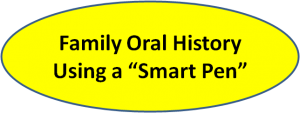This is part 2 of a two part series featuring recording Family Oral History at an 80th birthday party. This part will discuss how we used a “smart” pen to capture 2 hours of recordings AND notes. (View Part 1 here)
PenCasts – With LiveScribe Echo Smart Pen
The second day of our family gathering dawned clear, bright and windy at the lake. The “Elders” of the family were sitting around visiting and my aunt was recalling more stories, and writing them down. She realized the importance of having these stories. I left my Sony digital recorder running while they hashed out their versions and exclaimed “No, no…It was this way!”
“No, no…It was this way!”
This was great stuff.
After lunch we gathered for more stories. This time I brought out my newly purchased LiveScribe Echo Smart Pen. This is a gadget that is smart pen, computer and recorder combined and basically creates “PenCasts”. It is truly amazing.
I first saw a LiveScribe in action when Susan Kitchens (of Family Oral History Using Digital Recorders) interviewed me at SCGS Jamboree 2011 about my experiences recording family oral history.
The notes are made on special paper which can include triggers to jump to specific places in the recording. Take a look at the video (ABOVE) for more information about what it can do.
My aunt again was the impetus for the memories. I was asking questions about their life growing up and what it was like.
“Just how far did you walk uphill both ways to school??”
My Mom and Uncle would chime in with their version or to add to the story. We must have done this for couple of hours! It was another very successful recording experience.
I was glad I bought the 8GB version of the LiveScribe Echo Smart Pen!
I personally felt it was easier to interview with the LiveScribe Echo because while I was busy making notes and asking questions they forgot the LiveScribe was also recording. The conversations were natural and they flowed.
At one point I also turned on my Sony recorder and had it sitting on the table because there were lots of people chiming in from around the room. I didn’t know how far the LiveScribe could pick up the sound as this was my first experience with this gadget.
It was easier to interview with the LiveScribe Echo vs the digital recorder
My sister and I also did a LiveScribe Echo session where she went over a list of things she remembered from our childhood.
What Next?
I plan to make a master copy of the two sets of recordings for Mom (and for any family members who want it) plus I will transcribe the words into text to include in a photo album of Mom’s Big Day which she will receive as a gift. (Shhhhsss, don’t tell her!)
I’m actively blogging about our family stories and hope to put the blog posts together in a book one day. These recordings will help me recall the stories.
Most importantly is having the voices. I always regret we didn’t have my father’s voice recorded.
“Most importantly is having the voices.”
I now have many of family members on a recording whether it was from the Memories Game (see part 1) or from our post party activities on the next day.
Bottom line
Get creative with your oral family history interviews. Try interviews in a group setting and ask others to participate…and buy yourself a LiveScribe Echo. It is so much fun!
Acknowledgements
THANK YOU to Susan Kitchens (of Family Oral History with Digital Tools) and Lisa Alzo (of The Accidental Genealogist and an expert in publishing family histories) for their inspiration.
A special thank you to my extended family for their participation in recording our family oral history.
Family Oral History Equipment and Resources
- Sony IC Recorder available from Amazon (ICD-UX200) – my model is an old one so check the website for the latest available. (www.amazon.com). I suggest getting one with a USB connection.
- LiveScribe 8GB Echo Smartpen available from Amazon – (also used by university students recording notes in class). One has the option to purchase the 8 GB Pro Pack which has extra recording devices. (www.amazon.com or click on the photo below)
Note, you will need to purchase special notebooks to start. There is an option to print off your LiveScribe paper once you have the software installed on your computer.
LiveScribe NoteBooks – I recommend getting a medium size notebook. If you are student taking lots of notes go for the full size notebook.
Questions? Leave a comment below.
—
Please see my disclosure statement about my relationship with the vendors mentioned.
